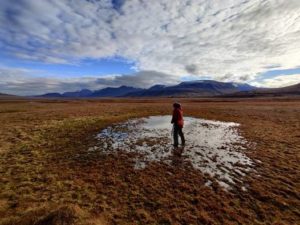Bryophytes dominate in wide regions of the Arctic, also presenting the dominant vegetation cover on Svalbard. The layer of bryophytes in moss tundra, with its insulating abilities, is a significant factor in preserving permafrost. Herbivore activity such as goose grubbing may damage and remove parts of the moss layer, and is expected to be a major driver of vegetation shift from moss-dominated to grass-dominated tundra. However, whether this herbivory-induced reduction of moss cover will lead to increases in active layer depth remains currently unknown. This study will focus on the development of active layer depth below intact vs. disturbed vegetation during summer.
Project description:
 The aim of this project is to monitor the effect of grubbing on active layer depth throughout the summer.
The aim of this project is to monitor the effect of grubbing on active layer depth throughout the summer.
The student will join an ongoing PhD project. You will assist with field work.
Development of active layer depth will be monitored over summer in sites with contrasting vegetation in Adventdalen. In each vegetation type, disturbed and undisturbed plots will be monitored. Abiotic variables, such as temperature and soil moisture, will be measured. Depending on interest, vegetation recordings can be included.
The project involves:
Fieldwork
Starting date/period:
From 1. June 2021 – to 30. September 2021
Prerequisites:
Able to carry and handle a rifle. Knowledge of the Svalbard Flora is a plus.
Experience/skills to be acquired:
The student will gain some knowledge on plant species as well as how to conduct abiotic measurements in the field. The student will also learn how to operate in a high Arctic environment where polar bears can be present.
Involvement:
Flexible (max 40h). It is recommended to work at least 7 h/day when being in the field.
Interested by this project? Need more info? Contact:
Simone Lang
simonel@unis.no
Project number: 15
